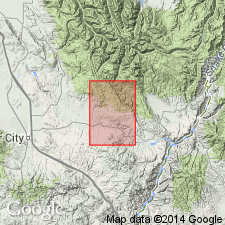
- Usage in publication:
-
- Gold Creek greenstone
- Modifications:
-
- Original reference
- Dominant lithology:
-
- Volcanics
- AAPG geologic province:
-
- Snake River basin
Summary:
Informal "Gold Creek Greenstone" used in this report to designate sequence of spilite and keratophyre flows with minor beds of mudstone, graywacke, and breccia which is exposed in area of about 3 sq. mi. in northeastern part of Sparta 15-min quadrangle. Unit is correlative with what has been called Clover Creek Greenstone in earlier papers (citing Ross, 1938, Oregon Dept. Geol. and Min. lnd. Bull., no. 3; Smith and Allen, 1941, Oregon Geol. and Min. lnd. Bull., no. 12). In Sparta quadrangle distinguished from Clover Creek Greenstone because it occupies different stratigraphic position. "Gold Creek Greenstone" underlies "Lower Sedimentary Series" whereas Clover Creek rocks nearer their type locality underlie Martin Bridge Formation. This corresponds to stratigraphic difference of about 3,000 feet. Because of small extent of "Gold Creek Greenstone" in this quadrangle a formal formational name is not proposed. Base of sequence not exposed but section must be at least 2,000 feet thick.
Type locality not designated. [Derivation of name not stated by author, but probably named from Gold Creek, a south-flowing tributary of Paddy Creek, in secs. 3, 4, 10, and 15, T. 7 S., R. 44 E., approx. Lat. 44 deg. 58 min. 35 sec., N., Long. 117 deg. 19 min. 05 min. W., Whitman National Forest, Sparta Butte 7.5-min quadrangle, Baker Co., OR.]
Source: US geologic names lexicon (USGS Bull. 1350, p. 294); Publication.

- Usage in publication:
-
- Gold Creek greenstone
- Modifications:
-
- Overview
- AAPG geologic province:
-
- Snake River basin
Summary:
Pg. 25. Gold Creek greenstone is an informal term proposed by Prostka (1962) for small exposures of Late Triassic greenstone south of the Wallowa Mountains, in the northeast corner of the Sparta 15-min quadrangle. Prostka (1963) and Vallier (1971, oral commun.) believe unit is equivalent to Wetherell's (1960) "Imnaha Formation" of the southern Wallowa Mountains. Prostka (1971, written commun.) also suggests it is equivalent to part of unit "A" of Clover Creek Greenstone of Prostka (1963) in the western part of Sparta quadrangle. Consists of approximately 2,000 feet of spilitic and minor keratophyric flows interbedded with subordinate amounts of graywacke, mudstone, and breccia. Thickens to the northeast, [into the adjacent Cornucopia quadrangle], where it can practically be walked into the "Imnaha Formation" (citing Prostka, 1971, written commun.). Base not exposed; Prostka (1971, written commun.) suggests the Gold Creek and his unit "A" of Clover Creek unconformably overlie Gilluly's (1937) Permian Clover Creek rocks, based on unconformable relationship between laterally equivalent "Imnaha Formation" and Permian strata to the north. However, Vallier (1971, oral commun.) believes that the laterally equivalent "Imnaha Formation," to the east, is a correlative of Clover Creek Greenstone. Conformably underlies "Lower Sedimentary Series." Age is Late Triassic, based on lithology and stratigraphic relations.
See also:
Prostka, H.J., 1963, "Geology of the Sparta quadrangle, Oregon," Johns Hopkins Univ. unpub. PhD thesis, 236 p.
Wetherell, C.E., 1960, "Geology of part of the southeastern Wallowa Mountains, northeastern Oregon," Oregon State Univ. unpub. MS thesis, 208 p.
Source: Publication.
For more information, please contact Nancy Stamm, Geologic Names Committee Secretary.
Asterisk (*) indicates published by U.S. Geological Survey authors.
"No current usage" (†) implies that a name has been abandoned or has fallen into disuse. Former usage and, if known, replacement name given in parentheses ( ).
Slash (/) indicates name conflicts with nomenclatural guidelines (CSN, 1933; ACSN, 1961, 1970; NACSN, 1983, 2005, 2021). May be explained within brackets ([ ]).

